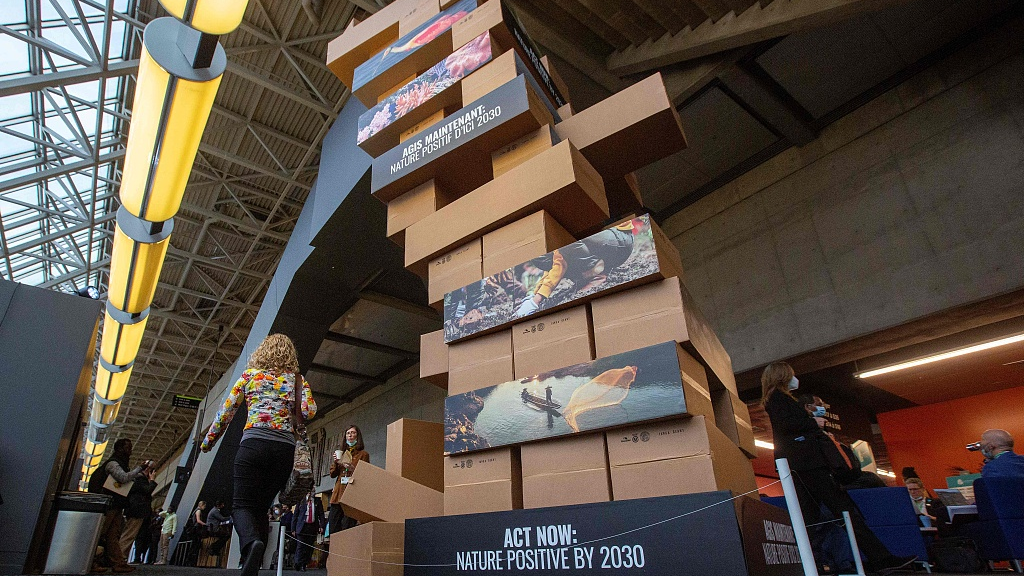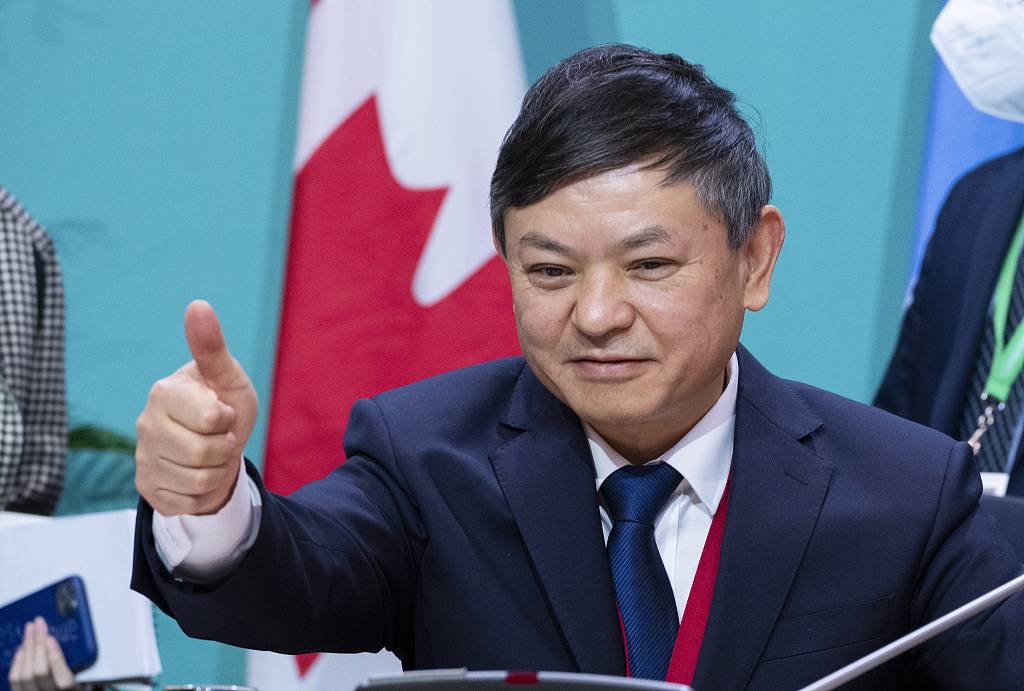
A person walks by a giant jenga game at the second part of the 15th Conference of the Parties to the UN Convention on Biological Diversity in Montreal, Canada, December 15, 2022. /CFP
A person walks by a giant jenga game at the second part of the 15th Conference of the Parties to the UN Convention on Biological Diversity in Montreal, Canada, December 15, 2022. /CFP
Editor's note: Alberto Ninio is General Counsel at the Asian Infrastructure Investment Bank and led its delegation at the second part of the 15th Conference of the Parties (COP15) to the UN Convention on Biological Diversity in Montreal, Canada. The article reflects the author's opinions and not necessarily the views of CGTN.
A million species are threatened with extinction and many within decades.
The growing biodiversity crisis could see more than 10 percent of all species becoming extinct by the end of this century, with severe consequences for nature, people, and economies. The Asia-Pacific region in particular could lose up to 63 percent of its GDP due to nature loss linked to climate change and development.
Sustainable infrastructure can play a crucial role in the protection of biodiversity and nature-positive outcomes. Building on the momentum from the 27th Conference of the Parties (COP27) to the UN Framework Convention on Climate Change, as well as the 15th Conference of the Parties (COP15) to the UN Convention on Biological Diversity, it's time to invest in infrastructure projects that connect people and safeguard natural environments, driving positive economic and ecological outcomes that support biodiversity.
Biodiversity protects natural environments that provide for people and economies, creating a sustainable source of vital resources for a wide range of sectors, from agriculture to forestry, to fishing and tourism. It can drive global economic growth too, with the World Economic Forum estimating that business opportunities from the natural world could lead to the creation of 191 million jobs by 2030. Many investors are turning their focus to biodiversity too, either due to consumer pressure, government legal action or by identifying the economic value intrinsic to it.
The historical Kunming-Montreal Global Biodiversity Framework (GBF) was adopted in the early hours of December 19 by COP15 President Huang Runqiu, providing a global roadmap for action over the years to 2030. It sets four goals and 23 targets, including to protect and restore at least 30 percent of the Earth's land and water by 2030. The framework calls to align financial flows with the GBF and its 2050 Vision for Biodiversity, and to enhance financial resources to narrow the biodiversity finance gap of $700 billion per year.

Huang Runqiu, President of the 15th Conference of the Parties (COP15) to the UN Convention on Biological Diversity, gives a thumbs up at the COP15 conference on biodiversity in Montreal, Canada, December 19, 2022. /CFP
Huang Runqiu, President of the 15th Conference of the Parties (COP15) to the UN Convention on Biological Diversity, gives a thumbs up at the COP15 conference on biodiversity in Montreal, Canada, December 19, 2022. /CFP
A specific commitment was also made to boost biodiversity-related international financial resources to developing countries – including those channeled through multilateral development banks (MDBs) – to reach at least $20 billion per year by 2025, increasing to at least $30 billion per year by 2030. According to the Organization for Economic Co-operation and Development, biodiversity-related bilateral and multilateral official development assistance are at approximately $10 billion per year today.
The GBF acknowledges the specific role that MDBs must play to raise international biodiversity funding, to mainstream biodiversity in development cooperation, and to enhance the effectiveness of resource use. At the Asian Infrastructure Investment Bank (AIIB), we stand committed to working in close collaboration with other MDBs and partners to support our member countries and clients in implementing the GBF including its vision, targets and decisions, by scaling up biodiversity finance and shifting investments toward a nature-positive world.
Averting biodiversity loss is a key priority and a growing area of investment. We have helped to fund the construction of a high-speed railway in Türkiye between Ispartakule and Cerkezkoy, an example of infrastructure that connects people and creates economic opportunities, while safeguarding biodiversity by protecting and enhancing natural habitats. Our approval of a 300 million euro loan helped replant woodland and install adapted fencing. These measures will protect two species of native plants and endangered animals, such as the White-Headed Duck, a species at risk of habitat loss across Europe.
Another recent example of how sustainable infrastructure can encourage economic growth while protecting biodiversity is in Indonesia. The AIIB's investment in the creation of a pumped storage hydropower, an energy storage system that will power Indonesia's green energy transition, could impact areas of habitats for animals that include Javan Slow Loris, Pangolins, Leopards and Javan Hawk-Eagles. The project ensures careful reforestation in impacted areas, alongside the installation of specially designed bridges to allow animals to cross safely.
We are also engaging with local communities to incentivize a reduction in practices that damage biodiversity, such as open field agriculture on steep slopes. In other regions, the AIIB and other MDBs are exploring the economic and financial benefits of investing in "natural infrastructure," such as mangroves and corals as ways to provide conventional infrastructure services such as flood protection and, at the same time, supporting ecosystems in need of support. These nature-based technologies can play a vital role in protecting animals, plants and natural environments, alongside the coastal communities whose livelihoods depend on them.
As biodiversity loss has become a global existential challenge, recent infrastructure projects that have involved MDBs, governments and investors demonstrate the importance of a collaborative, international approach to tackle the biodiversity crisis.
The AIIB has partnered with nine MDBs to issue a high-level Joint Statement on Nature, People and Planet at the COP26, committing ourselves to "further mainstream nature" into our policies, strategies, assessments, advice, investments, and operations, in line with our respective mandates and operating models.
One year later at the COP15, AIIB and other MDBs have jointly hosted the side event "The Role of the MDBs in Taking Forward the GBF: Delivering the joint MDB Nature Statement" to share progress, lessons learnt and show high-level leadership and support toward nature-positive financing. We will continue to enhance collaboration with MDBs through a newly established working group on nature, bringing together experts and practitioners to discuss opportunities and challenges related to mainstreaming nature across our institutions.
Nature loss may be widespread, but it is not inevitable. Through high standards, catalytic funding and partnerships, we can accelerate the urgent investments needed in sustainable infrastructure that protects biodiversity, connects communities, and drives economic growth, building resilience and long-term stability.
(If you want to contribute and have specific expertise, please contact us at opinions@cgtn.com. Follow @thouse_opinions on Twitter to discover the latest commentaries in the CGTN Opinion Section.)